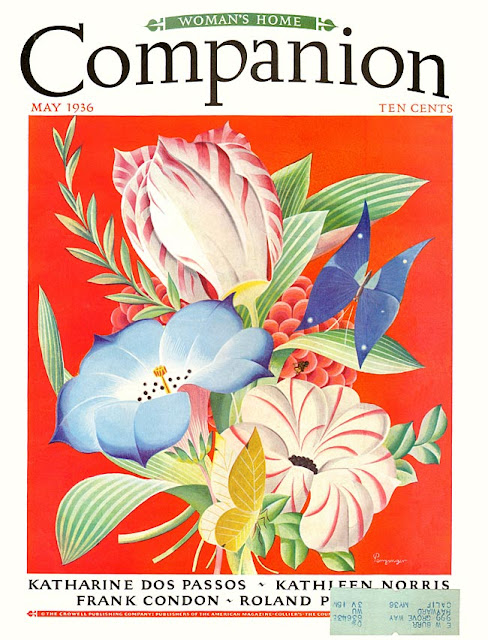[Image source: magazineart.org]
Of all the insects in the world, butterflies are quite possibly the most beautiful and the most fascinating. Given our love of butterflies, their bright colors, and their graceful motions, it's no wonder they have fluttered their way into many artistic depictions over the years. Today, we will be exploring these depictions on a variety of graphic arts, including magazine covers and book illustrations.
[Image source: magazineart.org]
The magazine cover above shows one of the more common associations we have with butterflies. Namely, that the sight of them is an everyday occurrence in rural areas. While magazines like these depict butterflies because of their ubiquity in rural settings, what's interesting here is that the uncommon beauty of the butterflies is what sells the magazine, and perhaps also the whole idea of living in the country.
But whether one lives in the country (or aspires to) or not, magazines devoted to everyday living also give butterflies the spotlight because of their sheer beauty. It's important to note that, like flowers, butterflies have a more feminine beauty to them, which is why you'll find more of them on covers of magazines geared towards women. The Woman's Home Companion (below) is one such magazine.
[Image source: magazineart.org]
On the other hand, the masculine appeal for butterflies is not so much as a thing of beauty, but more as an object to be studied and categorized. The mid-19th century scientific illustration below is an example of one such depiction.
[Image source: The New York Public Library]
Butterflies can also be represented more frequently in depictions of other cultures, particularly Asian cultures such as in Japan. Asian aesthetic was brought to the western world with the importation of silks and Asian art in the late 19th century, and with each coming decade, as communication between the western and eastern worlds gained more of a foothold, fascination with Asia and its people and culture became that much more ingrained in the collective mind of Western society. The below magazine cover is for a magazine that appealed to this fascination. The butterfly adds a nice touch, and it further cements the concept of Asian aesthetics as exotic and delicate.
[Image source: magazineart.org]
[Image source: The Lester S. Levy Sheet Music Collection]
Although not strictly a part of Asia, Hawaii has a similar aesthetic, and the delicate beauty of butterflies fits well. The above sheet music cover is an example of this.
[Image source: magazineart.org]
[Image source: magazineart.org]
The two magazine covers shown above are more subtle depictions of butterflies as decorative elements. As in the Asia magazine cover, they add a special something to graphic art while not serving a more prominent purpose.
Last but not least, the graceful beauty of butterflies also lends itself well to poetic and tonal uses, as in songs and music. The next few depictions are sheet music covers for songs and pieces of music about butterflies.
[Image source: The Lester S. Levy Sheet Music Collection]
[Image source: The Lester S. Levy Sheet Music Collection]
[Image source: The Lester S. Levy Sheet Music Collection]
---------
If you liked this post, please visit our website, where you can receive $20 towards the purchase of any print in our upcoming art store.
If you liked this post, please visit our website, where you can receive $20 towards the purchase of any print in our upcoming art store.



















































